News
 June 25, 2024
Published by Stephan Sponar
June 25, 2024
Published by Stephan Sponar
The question whether measurable quantities of a quantum object have definite values prior to the actual measurement is a fundamental issue ever since quantum theory has been introduced in the early 20th century. Leggett-Garg inequalities (LGIs) study temporal correlations of a single system, which are derived under the assumption of so called macro-realism. There it is assumed, that any (macroscopic) object, which may occur in two (or more) macroscopically distinct states, is at any given time in a definite one of those states. The predictions of quantum mechanics stand in stark contradiction with these realistic theories, which manifest in violations of LGIs. We report on an experiment that demonstrates the violation of an LGI with neutrons, where the final measured value of the Leggett–Garg correlator K = 1.120 ± 0.026, obtained in a neutron interferometric experiment, is clearly above the limit K = 1 predicted by macro-realistic theories. E. Kreuzgruber et al. Phys. Rev. Lett. 132, 260201 (2024) (24. Jun 2024)
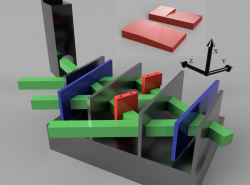 August 10, 2023
Published by Stephan Sponar
August 10, 2023
Published by Stephan Sponar
Neutron Orbital Angular Momentum (OAM) is an additional quantum mechanical degree of freedom, useful in quantum information, and may provide more complete information on the neutron scattering amplitude of nuclei. Various methods for producing OAM in neutrons have been discussed. In this work we generalize magnetic methods which employ coherent averaging and apply this to neutron interferometry. Two aluminium prisms are inserted into a nested loop interferometer to generate a phase vortex lattice with significant extrinsic OAM, 〈Lz〉≈0.35, on a length scale of≈220μm, transverse to the propagation direction. N. Geerits et al. Commun. Phys. 6, 209 (2023) (10. Aug 2023)
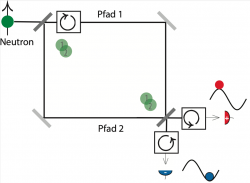 April 28, 2022
Published by Stephan Sponar
April 28, 2022
Published by Stephan Sponar
In our latest work we experimentally investigate the possibility that an individual neutron moving through a two-path interferometer may actually be physically distributed between the two paths. For this purpose, it is important to distinguish between the probability of finding the complete particle in one of the paths and the distribution of an individual particle over both paths. The results show that individual particles experience a specific fraction of the magnetic field applied in one of the paths, indicating that a fraction or even a multiple of the particle was present in the path before the interference of the two paths was registered, verified by the recently introduced method of feedback compensation. H. Lemmel et al. Phs. Rev. Research 4, 023075 (2022) (28. April 2022)
 July 1, 2021
Published by Stephan Sponar
July 1, 2021
Published by Stephan Sponar
According to the uncertainty principle, which is a corner stone of quantum mechanics, it is impossible to measure both position and momentum of an elementary particle (e.g. electron as in Heisenberg’s original argument) with arbitrary accuracy or in other word with zero error. One of the major problems in quantum physics has been to generalize the classical root-mean-square error to quantum measurements to obtain an error measure satisfying both soundness (to vanish for any accurate measurements) and completeness (to vanish only for accurate measurements). S. Sponar et al, npj Quantum Inf. 7, 106 (2021) (28 June 2021)
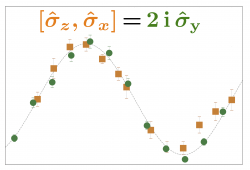 June 25, 2021
Published by Stephan Sponar
June 25, 2021
Published by Stephan Sponar
The canonical commutation relation is a tenet of quantum theory and Heisenberg’s uncertainty relation is a direct consequence of it. However, a genuine direct experimental test has not been performed up to Date. The reason for this is that the product of two non-commuting observables, as occurring in the commutation relation, is in general non-Hermitian and therefore cannot be measured by a usual strong measurement. We have overcome this hurdle by measuring the imaginary part of the weak value of a suited path-qubit in a neutron interferometer experiment, directly verifying the canonical commutation relation. R. Wagner et al, Physical Review Research 3, 023243 (2021) (24 June 2021)
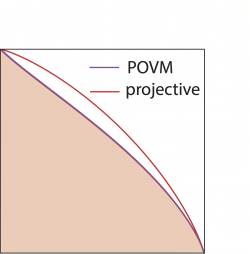 June 5, 2021
Published by Stephan Sponar
June 5, 2021
Published by Stephan Sponar
We experimentally tested a tight information-theoretic measurement uncertainty relation, in terms of a proposed three-outcome POVM using neutron spin-1/2 qubits. The obtained results of the noise-disturbance trade-off relation for three-outcome POVM outperform prior results for projective measurements. S. Sponar et al, Physical Review Research 3, 023175 (2021) (5 June 2021)
 February 8, 2021
Published by Stephan Sponar
February 8, 2021
Published by Stephan Sponar
In our paper, twisting neutral particles with electric fields, we demonstrate that a polarized neutron impinging on a longitudinally oriented electric field can obtain a unit of orbital angular momentum entangled to its spin degree of freedom. The coupling strength is proportional to the electric field strength and the transverse wavevector, which depends on the beam divergence. To obtain maximally entangled states the neutron must experience a voltage drop of roughly 10^8 V rad. While such fields are not feasible in laboratory environment they do appear naturally between the lattice planes of perfect crystals. Niels Geerits and Stephan Sponar, Physical Review A 103, 022205 (2021) (8 February 2021)
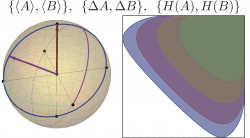 September 30, 2020
Published by Stephan Sponar
September 30, 2020
Published by Stephan Sponar
In our latest neutron polarimetric experiment we study tight state-independent preparation uncertainty relations for quits. The tight relations are based on the relationship between the expectation values of Pauli spin observables and two standard measures of uncertainty, namely standard deviations and Shannon entropies. We present a neutron polarimetric test of the tight state-independent preparation uncertainty relations for orthogonal, as well as non-orthogonal, Pauli spin observables. The final results, obtained with pure and mixed spin states, reproduce the theoretical predictions evidently for arbitrary initial states of variable degree of polarization. S. Sponar, A Danner, K Obigane, S Hack, and Y Hasegawa, Physical Review A 102, 042204 (2020) (6 October 2020)
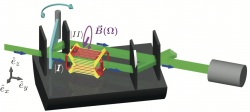 February 14, 2020
Published by Stephan Sponar
February 14, 2020
Published by Stephan Sponar
In our latest neutron interferometric experiment the effect of spin–rotation coupling, also referred to as Sagnac-Mashhoon phase was measured with neutrons. The coupling of spin with the angular velocity of a rotating magnetic field is an extension of the well-known Sagnac effect, including the intrinsic spin of a quantum mechanical particle when replacing the orbital angular momentum, by the total angular momentum. The principle of the experiment is the following: in one path of the interferometer the neutron’s spin is manipulated by a rotating magnetic field to undergo a cyclic path. As the orientations before and after the manipulation are the same, only a phase difference between the sunbeams is induced. This phase difference results in a shift of the observed interference fringes which turns out to depend solely on the frequency of the rotation of the magnetic field. A. Danner, B. Demirel, W. Kersten, H. Lemmel, R. Wagner, S. Sponar, and Y. Hasegawa, npj Quantum Information 6, 23 (2020) (14 February 2020)
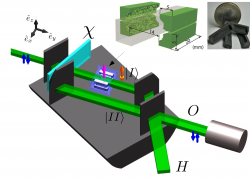 July 15, 2019
Published by Stephan Sponar
July 15, 2019
Published by Stephan Sponar
Topology-optimized 3D-printed magnets are interesting for Larmor spin-rotators in neutron optics in general, and in neutron interferometry in particular. Using 3D-printed magnets instead of magnetic coils avoids heat dissipation, which is the the main cause of loss in fringe visibility, due to temperature gradients in the interferometer. This study applies the technique to implement an arbitrary neutronic phase gate, for rotations of up to 4π of the neutron’s spinor wave function in one arm of the interferometer. This is achieved by varying the distance between the 3D-printed magnets, while maintaining homogeneity of the magnetic action over the neutron beam’s profile. W. Kersten, L. Brandl, R. Wagner, C. Huber, F. Bruckner, Y. Hasegawa, D. Suess, and S. Sponar, Additive-Manufactured and Topology-Optimized Permanent-Magnet Spin Rotator for Neutron Interferometry, Physical Review Applied 12, 014023 (2019). (12 July 2019)









